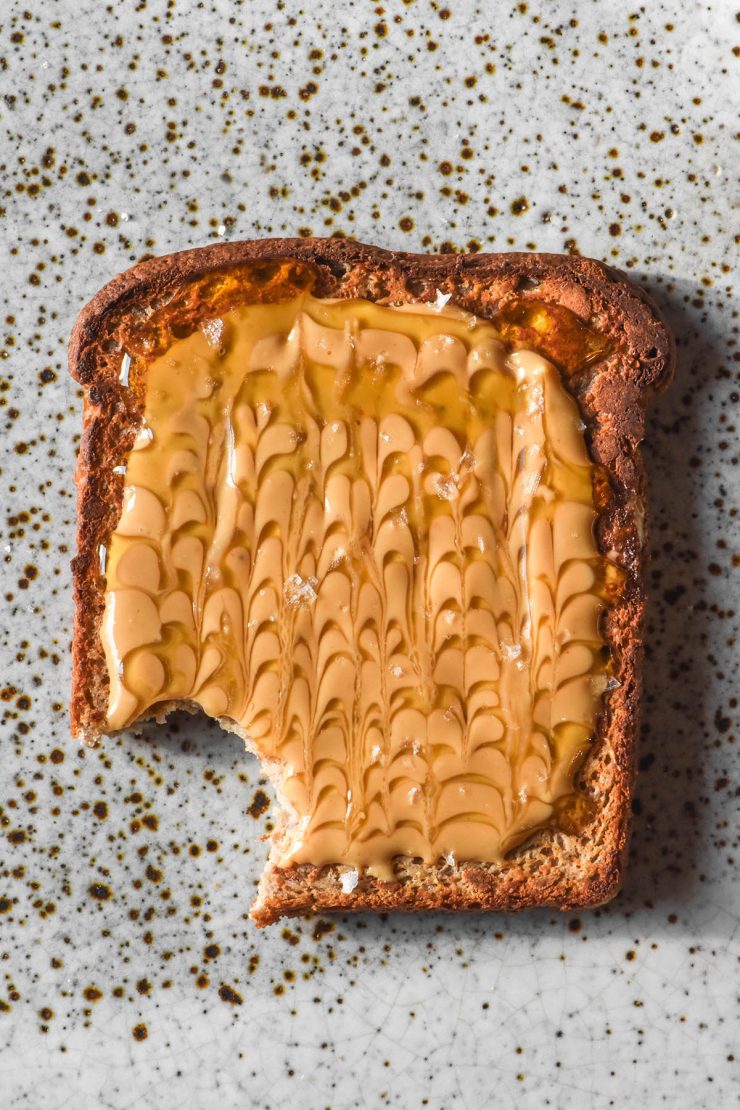
I recently published a recipe for gluten free high protein bread using cottage cheese. It’s my current breakfast fixation with 10g protein per slice (and I have two slices!). Although I love that version, I wanted to create a recipe for my vegan friends and for those who cannot eat dairy. As such, today’s recipe is this gluten free vegan high protein bread.
Gluten free vegan high protein bread
So how does one make a high protein bread without eggs or dairy? Simple – cannellini beans and buckwheat flour. Both ingredients are good protein sources that make a delicious slice of bread. Add in some optional hemp seeds and this bread contains 10g protein per slice, just like the original.
All in all, this recipe is vegan, xanthan gum free and nut free. It has a low FODMAP option as well.
What are cannellini beans?
Cannellini beans are also sometimes known as white kidney beans. They are a neutral flavoured bean with a creamy white flesh. As discussed below, I chose them both for their FODMAP content, neutral colour and neutral flavour. They are an excellent bean to blend into soups, sauces and stews without anyone noticing a thing. Their starchy nature is actually really at home in bread, replacing the starch that some gluten free breads use anyway.
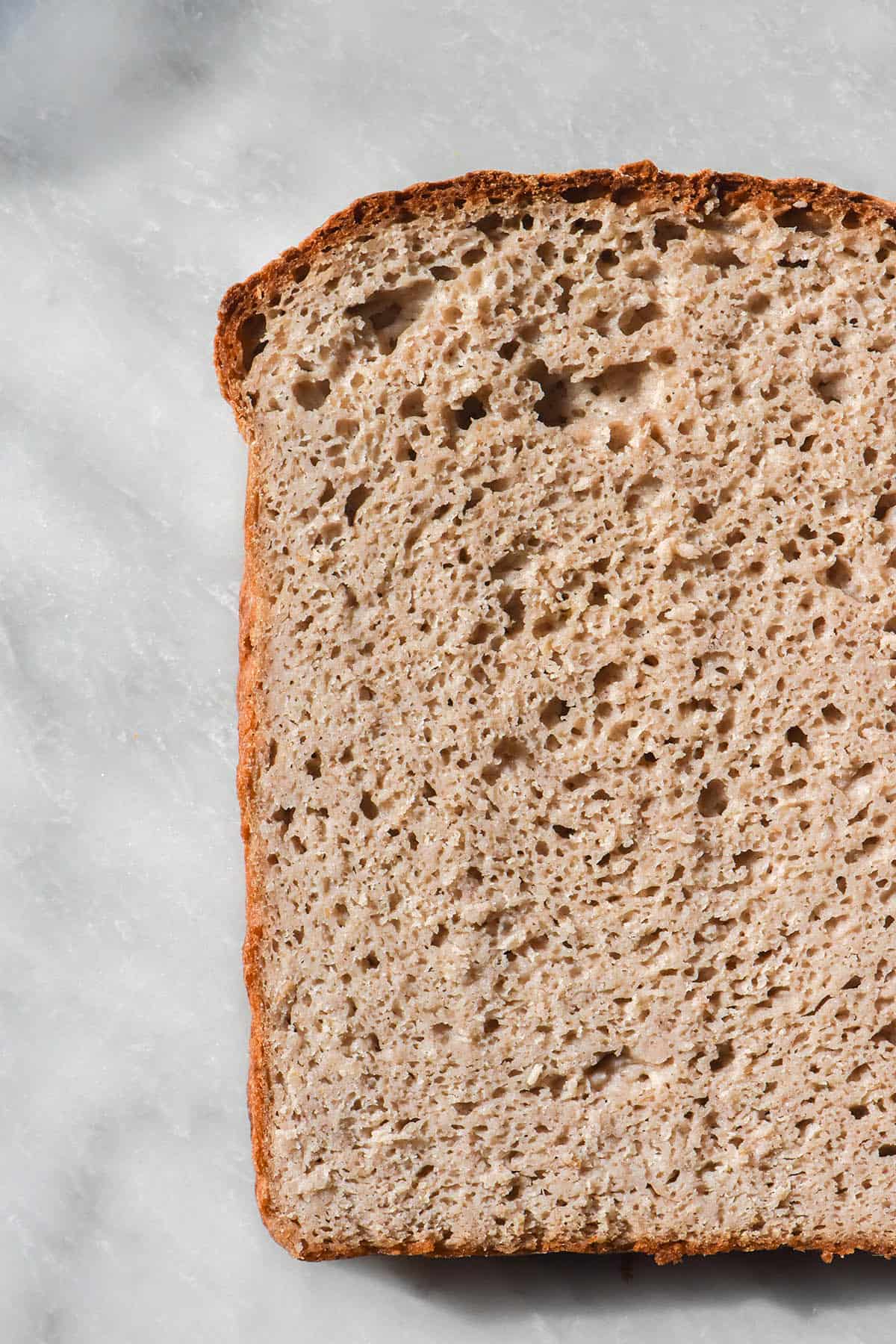
How much protein does this bread contain?
Although the protein content of products differs a little from brand to brand, here is a rough estimate of the protein content.
- 500g buckwheat flour (I used Terra Madre brand) = 60g protein
- 450g (2 drained 400g cans) of Coles Cannellini beans = 32g
- 75g (optional) hemp seeds = 33g
- Total = 125g protein, divided by 12 slices = 10.4g protein per slice
The hemp seeds are optional for those with FODMAP constraints, as we will discuss below. Without the hemp seeds, each slice contains approximately 7.6g of protein. A little less, but still good for bread.
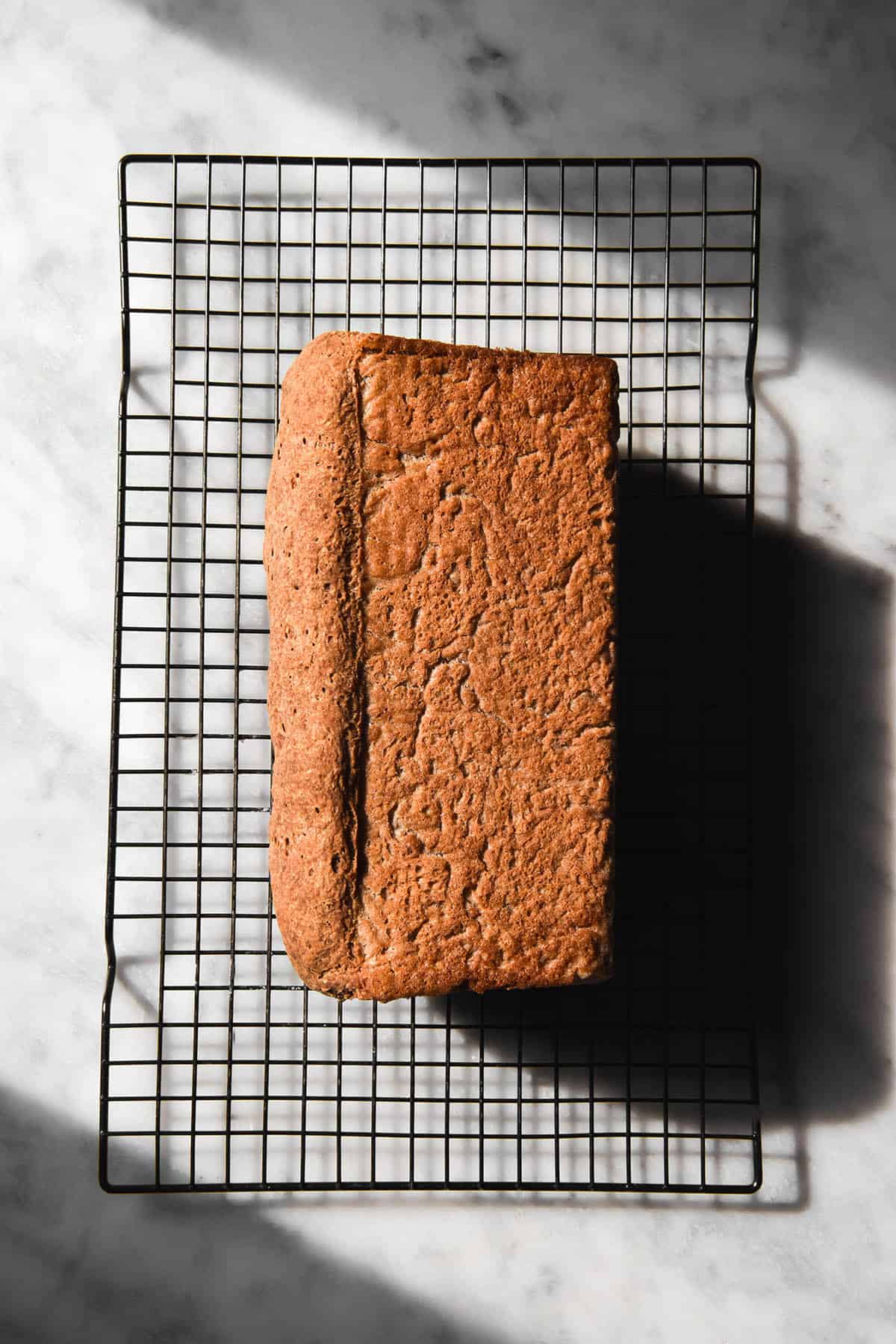
FODMAP notes
Legumes are not traditionally known as a FODMAP friendly ingredient. Thanks to the advent of canned legumes, however, they can jump back onto the menu. Canned beans are lower FODMAP because their FODMAP content leeches out into the canning liquid. As a result, they can be consumed in higher quantities than dried beans.
I chose canned cannellini beans for this recipe because they are low FODMAP in 76g serves. This is one of the higher thresholds for a canned legume. It also helps that cannellini beans are neutral in flavour and white in colour. They blend effortlessly into the bread dough and don’t leave many hints behind.
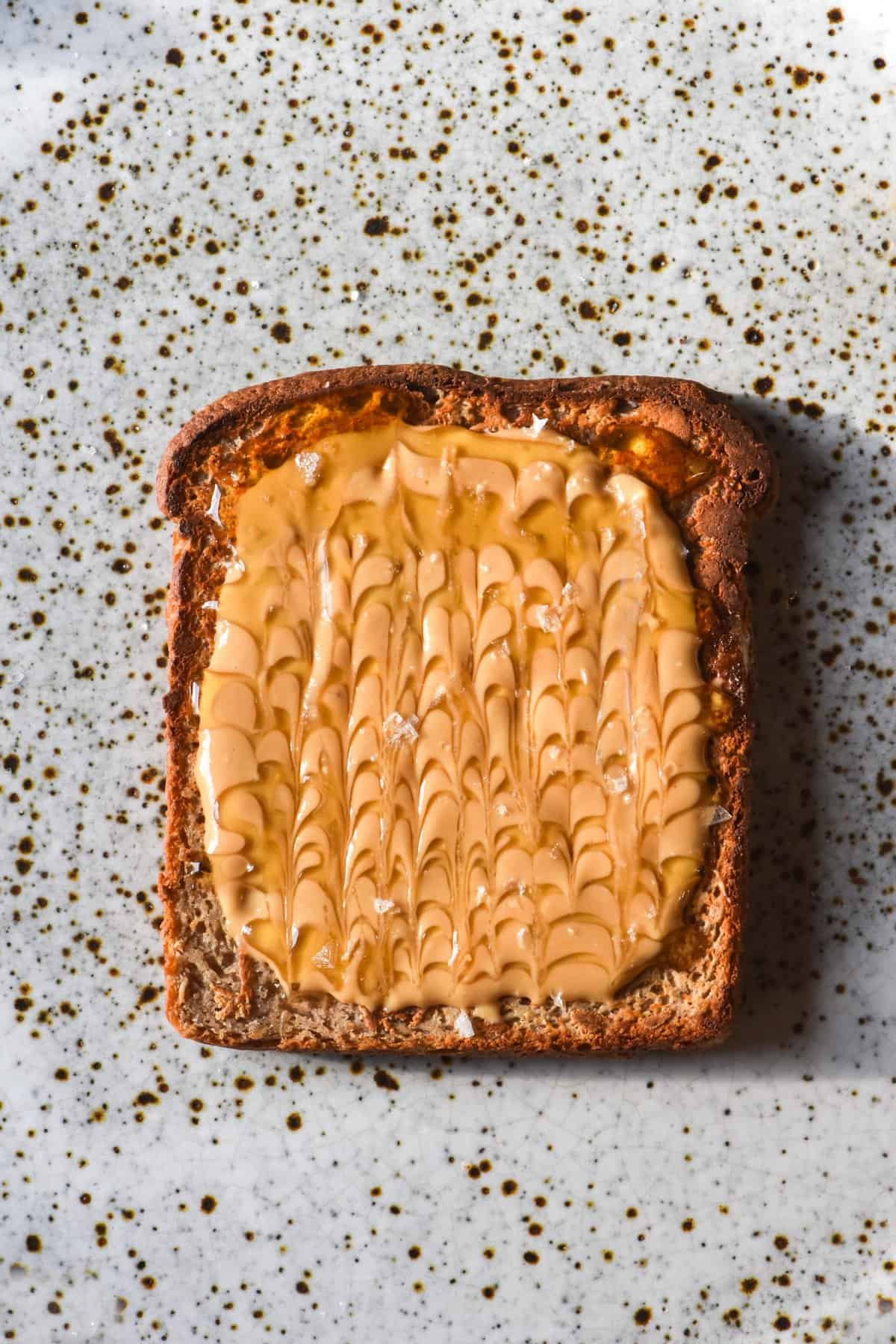
Recipe substitutions for your gluten free vegan high protein bread
There are not many available substitutions here, but I thought it might be helpful to outline what I have not tested.
- I haven’t tested any other variety of bean or dried and soaked beans.
- The yeast is for leavening and I haven’t tested a version without this. There is a yeast free buckwheat bread recipe (not high protein) in my cookbook Intolerance Friendly Kitchen.
- Buckwheat flour has been purposefully chosen because of it’s protein content. I haven’t tested and don’t intend to test a version made with other flours. Here is a roundup of all my gluten free bread recipes (most are not buckwheat based).
- If you don’t want to use beans, you can see my original cottage cheese version. If you don’t want to use dairy, I have a vegan gluten free buckwheat bread recipe here (not high protein).
- The oil is to create a nice and soft bread and the maple syrup is to aid rise and disguise any bean flavour. Neither can be omitted.
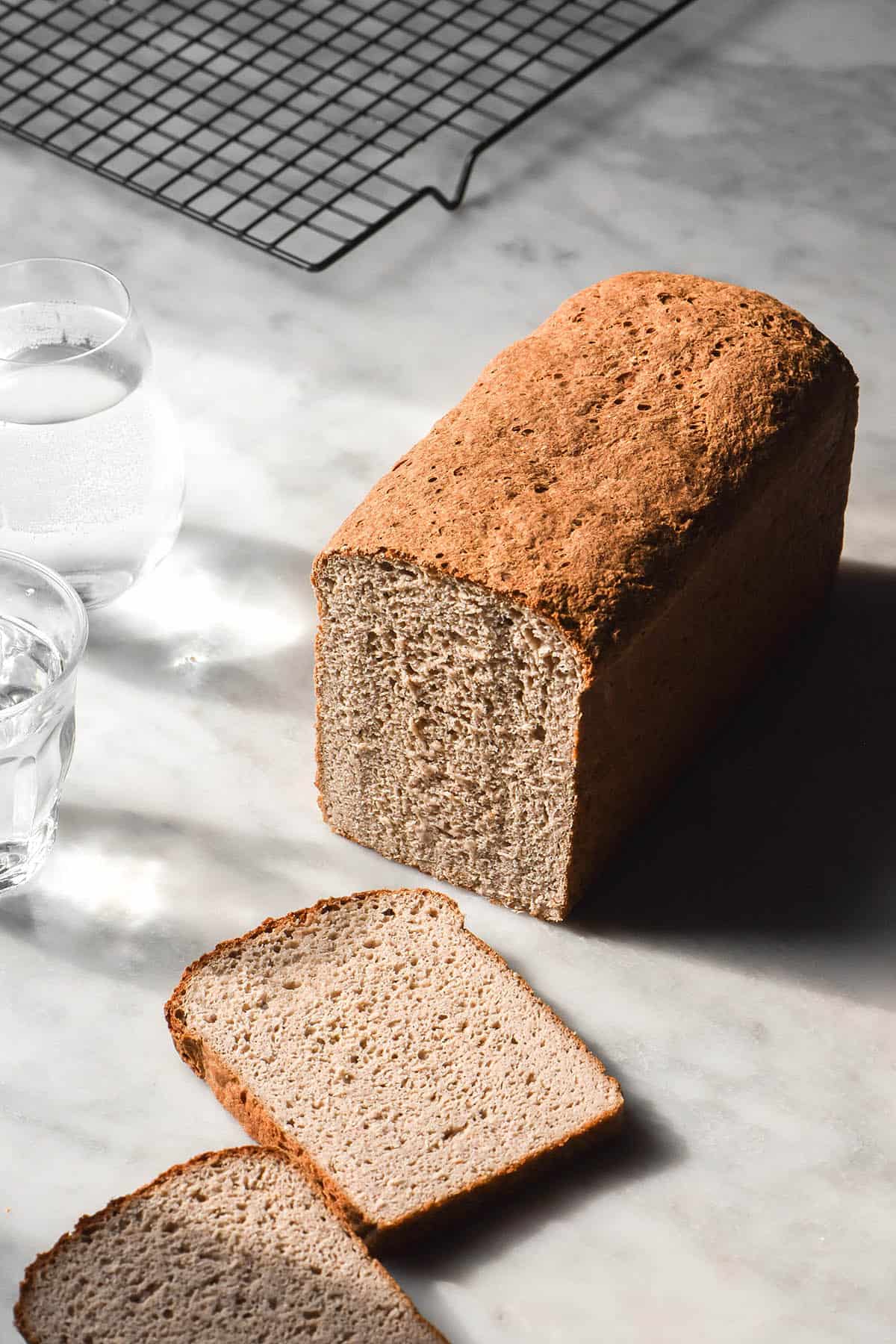
Hydration notes
There are a few factors at play when it comes to adequate hydration for this bread. Firstly, the starchy beans require a considerable amount of additional water when compared to the cottage cheese version.
Secondly, as always, a more hydrated loaf makes for a taller loaf. Yeast needs a moist environment to thrive, so higher hydration loaves tend to have a more open crumb. The flip side of that is that the bread can taste a bit ‘beany’ with a higher hydration. I’m not sure why this is the case – it might be because the crumb is quite wet when first cooked. This goes away after the bread is totally cooled, but worth noting nonetheless.
As with the cottage cheese version, I think this bread is best used for toast. When toasted and topped with your choice of toast topping, you cannot taste beans.

More gluten free vegan bread recipes
- Gluten free vegan bagels
- 100% buckwheat flour seeded pumpkin bread
- Gluten free sourdough bread
- Vegan, gluten free focaccia
- My original gluten free buckwheat bread recipe
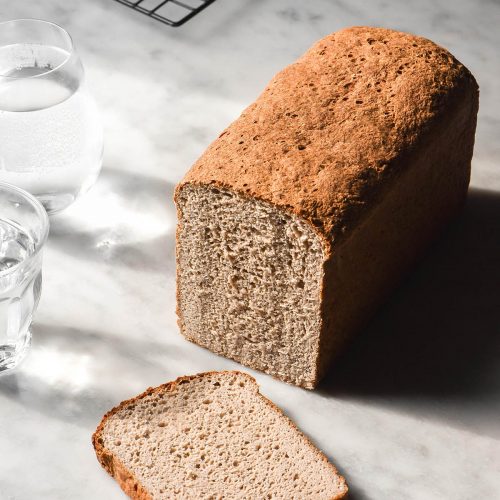
Gluten free vegan high protein bread
Equipment
- 10cm X 10cm X 23cm steel loaf pan (see notes)
Ingredients
For the loaf:
- 500 g light buckwheat flour
- 25 g psyllium husk powder
- 5g (1 teaspoon) gluten free baking powder
- 7.5 g (1 sachet) yeast
- 10 g fine salt see notes
- 100-200 g extra water
- 75 g hemp seeds optional, see notes
For the blended mixture:
- 450 g canned and drained cannellini 2 x 400g tins, drained
- 600 g water
- 60 ml (3 tablespoons)* neutral oil (I used vegetable)
- 20 ml (1 tablespoon)* maple syrup
Instructions
- Whisk the dry ingredients for the loaf (except for the optional hemp seeds) in a large non-reactive (plastic or glass) mixing bowl. Weigh out the 100-200g extra water for the loaf in a glass and set aside.
- Combine the ingredients for the blended mixture in your blender and process until combined.
- Pour the blended mixture into the dry ingredients.
- Use a whisk to combine until a smooth, thick batter forms. It should be very sticky and just a little too wet to hold its shape in the bowl. If it looks dry or holds its shape, add the extra water and stir to combine.
- Cover the bowl and leave on the bench to proof for 1 hour.
- Grease and line a 10cm X 10cm X 23cm steel loaf pan. After the 1 hour is up, stir in the (optional) hemp seeds, then decant the batter into the loaf pan and use a wet hand to flatten and smooth the top. Cover the loaf and proof for another 30-60 minutes or until it has reached the top of the loaf pan.
- While you are waiting, preheat the oven to 220C/428F.
- When the loaf is proofed, place it in the oven for 50 minutes or until golden brown and firm on top. Check on it at the halfway point and turn the oven down to 200C/400F if it’s looking too browned.
- Allow the loaf to cool for 15-20 minutes in the tin before carefully removing to place on a cooling rack. Allow to cool before slicing.
- This bread is best as toast and keeps well in the fridge for a number of days. You can also slice the bread and toast it straight from frozen.
Notes
- I use a size small Pullman steel bread pan for all my loaves. A silicon pan or any short pan is not appropriate here, nor is a larger Pullman. This recipe has been designed with this pan, and using a different one will achieve an unknown result. Steel is the only pan appropriate for bread as it holds the bread while it proofs upwards.
- Hemp seeds are optional and boost the protein content of this loaf. If you are low FODMAP, consuming beans and hemp seeds together might push the GOS content of the loaf up too much. See what works for you, but omit them if you know you are highly sensitive to GOS.
- Read notes in the body of the post for tips, suggestions and substitution options.
- This bread is best as toast and can taste a little bit ‘beany’ if you eat it fresh.

Thank you for making a vegan option for your high-protein bread, this sounds delicious.
I was wondering whether you think silken tofu would work as a substitute for the cannellini beans in the recipe as personally, I am able to tolerate it better than beans.
If you haven’t tested a version with silken tofu yet, do you think you would be able to as I know you would be much better at making any necessary adjustments to the other ingredients than I would.
Thank you!
Hi Kirilly! I haven’t tested a silken tofu version and I don’t work with silken tofu often because it’s high FODMAP so not great for me.
I do plan to test a silken tofu version at some point but I currently have a freezer full of this bread to get through first haha.
Unfortunately I can’t offer any tips just yet but I will update the post when I do 🙂
Thank you so much for your reply, I completely understand and look forward to when you have time to test out the silken tofu version.